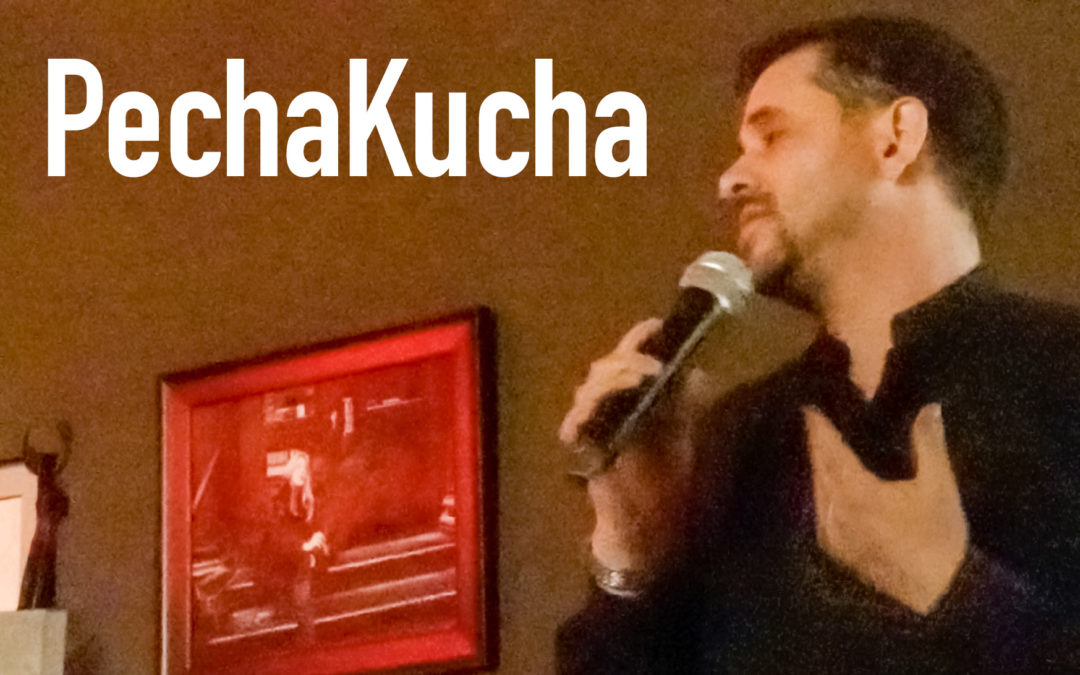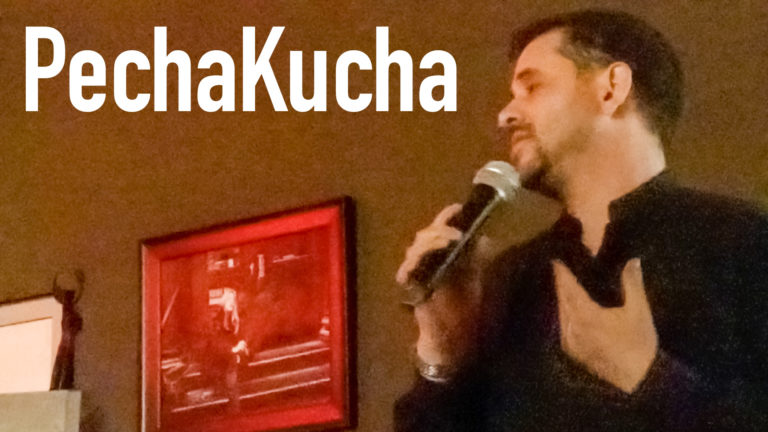20 slides, 20 seconds each.
PechaKucha is the new presentation format that’s all the rage, and it’s very simple to understand:
- You get 20 slides.
- Each slide is displayed for 20 seconds.
- You do not have control over the timing.
- One slide (20 seconds) between each presenter.
More information at pechakucha.org.
That’s it!
20 slides, at 20 seconds each, comes to 6 minutes and 40 seconds. Add a slide between presenters, and the pace will be 7 minutes per speaker. The guarantee that nobody exceeds their allotted time is wonderful for event producers. A half hour block contains 4 talks (28 minutes); an hour will fit 8 talks into 56 minutes.
The transitions between presenters are customarily handled with one slide between each presenter, showing the name of the next person to speak. That slide, same as all the rest, stays up for 20 seconds. So when a presenter finishes, and sees the name of the next person appear, it’s time to stop talking and hand the mic to the next person who is walking onto the stage.
All producers have faced the challenge of slow speakers taking time away from other presenters, but the pressure of this format compels compliance.
Bringing People Together
It also has a pleasant side-effect, which the brilliant public speaking coach Kelsey Crouch called to my attention: It brings the audience and the speaker closer, making the struggle into a shared challenge. She told me this before I saw my first PechaKucha, and I thought it sounded like nonsense. But it was absolutely true, and an astute observation!
Maintaining Focus
It is nearly impossible for an audience to be bored during PechaKucha. If a speaker loses their place, or begins to digress, the slide will be gone in moments and the presenter will realize the need to skip ahead to the next subject. Even if an entire presenter is dull, or if one of the talks holds little interest for the audience, everyone knows that the next speaker will be up in just a few minutes.
One of the largest barriers between public speakers and audience members is boredom. A few dull sentences at the start of a talk, and the audience begins checking their phones. Or even if they’re too respectful to openly shift their attention, they may internally “check out” and let their minds drift to other subjects. Their grocery list. What they’re going to say to that co-worker who has been annoying them. A romantic prospect. Cocktails after the session is over.
PechaKucha is the most powerful weapon I have seen, against boredom in audience members.
Easy to Prepare
It’s also great for presenters and producers. When presenters learn that they need only prepare 20 slides, it reduces the scope of work they must prepare for an appearance. This makes it easier for producers to book people. (“Hey, doing this talk will be no trouble at all for you.”)
In the course of the 50+ TED Talks I’ve produced, my team and I have spent tremendous time explaining to people that they can’t deliver their “usual hour-long talk”, but they need to comply with a much shorter timeline. However, when I say “you’re invited to do a 7-minute PechaKucha; you get 20 slides for 20 seconds each,” the discussion is over. They smile and say, “oh, ok – I guess I can do that.”
And even if they don’t do much by way of preparation, I know that everything will be fine in the end. The presenter will make sure they hit their key points, and if they don’t then their struggle will amuse the crown. My audience won’t be mad, because the format goes by too quickly. For a producer, there’s no greater joy than having that level of confidence.
Here’s my first attempt at delivering a PechaKucha:
https://www.youtube.com/watch?v=nB8iS8lpjdI
Reflections on my own first attempt:
As a TEDx producer, I frequently urge presenters to rehearse many times. Yet for this piece, somehow I failed to follow my own advice — and I definitely felt the pressure when I realized that my slides were advancing ahead of me. A few more practice runs, with the clock ticking, and I could have given a much more smooth delivery.
In my defense, I thought that I would have control over the advance of my own slides. Having been through this experience, I think it’s way better that the slides advance automatically. But I would have prepared differently if I had known. Many of the other presenters were similarly surprised when the event began.
Overall, I’ve fallen immediately in love with this format, and I plan to use it more at conferences and events of my own.

